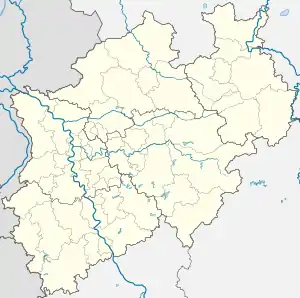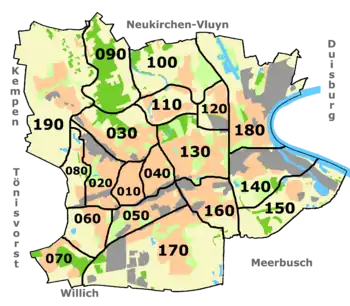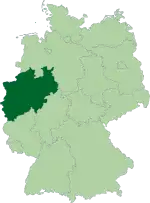Krefeld
Krefeld (/ˈkreɪfɛld, -ɛlt/ KRAY-feld, -felt,[2][3][4][5] German: [ˈkʁeːfɛlt] (![]() listen)), also spelled Crefeld until 1925 (though the spelling was still being used in British papers throughout the Second World War),[6] is a city in North Rhine-Westphalia, Germany. It is located northwest of Düsseldorf, its center lying just a few kilometres to the west of the river Rhine; the borough of Uerdingen is situated directly on the Rhine. Because of its economic past, Krefeld is often referred to as the "Velvet and Silk City". It is accessed by the autobahns A57 (Cologne–Nijmegen) and A44 (Aachen–Düsseldorf–Dortmund–Kassel).
listen)), also spelled Crefeld until 1925 (though the spelling was still being used in British papers throughout the Second World War),[6] is a city in North Rhine-Westphalia, Germany. It is located northwest of Düsseldorf, its center lying just a few kilometres to the west of the river Rhine; the borough of Uerdingen is situated directly on the Rhine. Because of its economic past, Krefeld is often referred to as the "Velvet and Silk City". It is accessed by the autobahns A57 (Cologne–Nijmegen) and A44 (Aachen–Düsseldorf–Dortmund–Kassel).
Krefeld | |
|---|---|
 City Hall | |
 Flag  Coat of arms | |
Location of Krefeld 
| |
 Krefeld  Krefeld | |
| Coordinates: 51°20′0″N 06°34′0″E | |
| Country | Germany |
| State | North Rhine-Westphalia |
| Admin. region | Düsseldorf |
| District | Urban districts of Germany |
| Government | |
| • Lord mayor | Frank Meyer (SPD) |
| Area | |
| • Total | 137.68 km2 (53.16 sq mi) |
| Elevation | 39 m (128 ft) |
| Population (2019-12-31)[1] | |
| • Total | 227,417 |
| • Density | 1,700/km2 (4,300/sq mi) |
| Time zone | UTC+01:00 (CET) |
| • Summer (DST) | UTC+02:00 (CEST) |
| Postal codes | 47701-47839 |
| Dialling codes | 02151 |
| Vehicle registration | KR |
| Website | www |

Krefeld's residents speak Hochdeutsch, or standard German, but the native dialect is a Low Franconian variety, sometimes locally called Krefelder Plattdeutsch, Krieewelsch Platt, Plattdeutsch, or sometimes simply Platt. The Uerdingen line isogloss, separating general dialectical areas in Germany and neighboring Germanic-speaking countries, runs through and is named after Krefeld's Uerdingen district, originally an independent municipality.
History
Early history
Records first mention Krefeld in 1105 under the name of Krinvelde.
In February 1598, Walburga, wife of Adolf van Nieuwenaar, and last Countess of Limburg and Moers, gave the County of Moers, which included Krefeld, to Maurice, Prince of Orange. After her death in 1600, John William of Cleves took possession of these lands, but Maurice successfully defended his heritage in 1601. Krefeld and Moers would remain under the jurisdiction of the House of Orange and the Dutch Republic during the Dutch Golden Age.[7] The growth of the town began in that century, partially because Krefeld was one of few towns spared the horrors of the Thirty Years' War (1618–1648). The town of Uerdingen, incorporated into Krefeld in the 20th century, was less fortunate, almost ceasing to exist, destroyed at the hands of troops from Hesse during the Thirty Years' War.
After the death of William III of Orange in 1702, Krefeld passed to the Kingdom of Prussia.[7] The Battle of Krefeld occurred nearby in 1758 during the Seven Years' War. Krefeld and Uerdingen were included within the Prussian Province of Jülich-Cleves-Berg in 1815 (after 1822 the Rhine Province).
In 1872 Krefeld became an independent city within Rhenish Prussia. In 1918 during the First World War the Belgian Army used it as a base during the occupation of the Rhineland. In 1929 Krefeld and Uerdingen merged to form Krefeld-Uerdingen; in 1940 the name was shortened to simply Krefeld.
The Mennonites of Krefeld
From 1607 Mennonites arrived in Krefeld, as in nearby Gronau, from neighboring Roman Catholic territories where they were persecuted. They sought refuge in the lands of the more tolerant House of Orange-Nassau, at the time rulers of Krefeld; in 1657 their congregation was officially recognized and in 1693 they were allowed to build their own church, although hidden in a back yard (which still exists, reconstructed after World War II, with about 800 members). Also the Quaker Evangelists received a sympathetic audience among the larger of the German-Mennonite congregations around Krefeld, Gronau, Emden and Altona, Hamburg.[8] In 1683 a group of thirteen Mennonite families (twelve of them Mennonite-Quakers) left Krefeld to re-settle in Pennsylvania in order to enjoy religious freedom. They crossed the Atlantic on the ship Concord,[9] and founded the settlement of Germantown (now incorporated in Philadelphia), invited by William Penn, and thus beginning the Pennsylvania Dutch ethnic identity.[10] The most important Mennonite family of Krefeld were the silk merchants and silk weaving industrialists Von der Leyen who, by 1763, employed half of Krefeld's population of 6,082 in their factories. Their residence, built from 1791, is the current City Hall.
The Jews of Krefeld
Jews were listed as citizens of Krefeld from 1617. In 1764 a synagogue was erected, and by 1812, under French rule, the town included 196 Jewish families, with three Jewish-owned banks. Under Napoleon, the town became the capital for the surrounding Jewish communities including over 5000 Jews, and by 1897 they comprised 1.8% of the population.[11] In 1846 a Jewish representative was voted onto the town's municipal council, while rising antisemitism was noted during these elections.[11] A reform synagogue was built in 1876, arousing opposition from the Orthodox community. A Jewish school existed in the town, with more than 200 students around 1900.[11]
In November 1938 during Kristallnacht, the two synagogues were attacked. In 1941 following an order from Hitler to deport the German Jews to the east, Jews from the town were sent to the area around Riga[12][11] and murdered there.[13] In 1945, the U.S. Army occupied the city and placed Henry Kissinger, then an Army private and later Secretary of State of the United States, in charge of the city administration.[14]
In 2008 a new synagogue, library and Jewish cultural center were erected on the location of one of the demolished synagogues. Around 1100 Jews were reported to live in and around Krefeld at the time.[15]
World War II
On 11 December 1941, during World War II, a detailed report on the transport of Jews from Krefeld and its surroundings listed 1007 Jews from Krefeld and Duisburg, were deported to the Šķirotava Railway Station near Riga, later to become Jungfernhof concentration camp. They were transported in freezing conditions with no drinking water for more than two days.[12] Almost immediately upon arrival they were shot in the Rumbula forest massacre.[13]
On 21 June 1943 British bombs destroyed many buildings in the east part of the city; a firestorm consumed large parts of the city center (apart from the central train station, which remained intact apart from minor damage). On 3 March 1945 US troops entered Krefeld, among them the later U.S. Secretary of State Henry Kissinger.
During the Cold War, the city was host to the 16th Signal Regiment of the United Kingdom's Royal Corps of Signals stationed at Bradbury Barracks.[16] The town became part of the new state of North Rhine-Westphalia after World War II.
Points of interest

- Linn Castle (German)
- Botanischer Garten Krefeld, a municipal botanical garden
- Krefeld Zoo
- Lange and Esters Houses, neighbouring houses by early Mies van der Rohe, now serving as local contemporary art museum venues[17]
- Kaiser Wilhelm Museum,[18] contemporary art museum
- German Textile Museum
- Galopprennbahn Krefeld, horse racing track
- The well-preserved historic old towns of the formerly independent districts Uerdingen, Linn and Hüls
Districts

There are a number of districts in Krefeld. Each has a municipal representative, with representatives chosen by local elections. The districts are:
|
Incorporations
Cities and places that were incorporated into Krefeld:
- 1901: Linn (Stadtrecht since 1314)
- 1907: Bockum, Verberg und Oppum (all mayoralty Bockum)
- 1929:
- Krefeld became an independent city
- Uerdingen, Krefeld (received municipal law in 1255/1344, added Hohenbudberg in today's Duisburg district Friemersheim)
- Fischeln, Krefeld district
- Traar, Krefeld district
- Gellep and Stratum (in Lank), Krefeld district
- Forstwald (Vorst), Krefeld district
- Benrad und Hülserberg (Hüls), Kempen
- 1975: Locality of Hüls from Kempen (since 1970 integrated and belonged since 1929 to the Kempen-Krefeld district; in 1936 Orbroich had been independent)
Historical population of Krefeld
|
|
¹ Census data
Largest migrant communities in Krefeld by 31.12.2017 are :
| 7,805 | |
| 4,510 | |
| 2,610 | |
| 2,530 | |
| 2,225 |
Mayors of Krefeld from 1848
- 1848–1872: Ludwig Heinrich Ondereyck
- 1872–1881: Friedrich Christian Roos
- 1882–1903: Ernst Küper
- 1903–1905: Wilhelm Hammerschmidt
- 1905–1911: Adalbert Oehler
- 1911–1930: Johannes Johansen
- 1945–1946: Johannes Stepkes
- 1946–1947: Wilhelm Warsch
- 1947–1949: Hermann Passen
- 1949–1951: Hanns Müller (FDP)
- 1951–1956: Johannes Hauser (CDU)
- 1956–1961: Josef Hellenbrock (SPD)
- 1961–1968: Herbert van Hüllen (CDU)
- 1968–1982: Hansheinz Hauser (CDU)
- 1982–1989: Dieter Pützhofen, first term in office (CDU)
- 1989–1994: Willi Wahl (SPD)
- 1994–2004: Dieter Pützhofen, second term in office (CDU)
- 2004–2015: Gregor Kathstede (CDU)
- 2015–present: Frank Meyer (SPD)
City counsellors 1946 until 1999
- 1946–1949: Johan Stepkes
- 1949–1964: Bernhard Heun
- 1964–1986: Hermann Steffens
- 1986–1988: Alfred Dahlmann
- 1988–1999: Heinz-Josef Vogt
Transport

Krefeld is connected to the Deutsche Bahn network with several stations, including its main station, Krefeld Hauptbahnhof. They are served by Intercity, Regional-Express and Regionalbahn trains. The Düsseldorf-based Rheinbahn operates a Stadtbahn service to the centrally located Rheinstraße stop. This line was the first electric inter-city rail line in Europe, established in 1898, and commonly called the K-Bahn because of the letter "K" used to denote the trains to Krefeld. Nowadays, in the VRR notation, it is called U76, with the morning and afternoon express trains numbered as U70, the line number there coloured red instead of the usual blue used for U-Bahn lines. The term K-Bahn, however, prevails in common usage.
The city of Krefeld itself operates four tramway and several bus lines under the umbrella of SWK MOBIL, a city-owned company. Since 2010, 19 of the oldest trams of the type Duewag GT8 were replaced by modern barrier-free trams of the type Bombardier Flexity Outlook. SWK Mobil owns an option to buy another 19 trams of the same type to replace the last 19 Duewag M8 trams. The whole tram fleet will then be barrier-free. Next to that the city plans to extend the line 044 in Krefeld-Hüls to connect the northern district of Hüls with the Krefeld downtown area.
Economy
The headquarters of Fressnapf, a pet food retailer franchise company, are situated in Krefeld.
International relations
Since 1964,[20] the city has hosted an "honors program in foreign language (German) studies" for high school students from Indiana, United States. The program annually places approximately thirty carefully selected high school juniors with families in and around Krefeld for intensive German language training.[21] Since 1973, the fire services of Krefeld and twin city Leicester have played each other in an annual 'friendly' football match.[22]
Twin towns – Sister cities
Krefeld is twinned with:
| Country | City | County/District/ Region/State |
Date | |||
|---|---|---|---|---|---|---|
| Netherlands | Venlo | Limburg | 1964 | |||
| United Kingdom | Leicester | Leicestershire | 1969 | |||
| France | Dunkirk | Nord | 1974 | |||
| Netherlands | Leiden | South Holland | 1974 | |||
| United States | Charlotte | North Carolina | 1986 | |||
| Germany | Beeskow | Brandenburg | 1990 | |||
| Russia | Ulyanovsk | Ulyanovsk Oblast | 1993 | |||
| Turkey | Kayseri | Kayseri Province | 2009 |
Notable natives
Scientists:
- Edmund ter Meer (1859-1931), chemist and industrialist
- Fritz ter Meer (1884-1967), chemist and industrialist
- Charlotte Auerbach (1899–1994), genetic scientist, born here
- Rudi Dornbusch (1 December, 8 June 1942 – 25 July 2002), economist
- Max Zorn (6 June 1906 – 9 March 1993 in Bloomington, Indiana), mathematician
- Leopold Löwenheim, (1878–1957), German logician
Writers, poets and journalists:
- Bernhard Hennen (born in 1966), German best-seller writer of fantasy literature
- Kurt Feltz (14 April 1910 – 3 August 1982 in Majorca), poet
- Bodo Hauser (1946-2004), journalist and writer
- Margarethe Schreinemakers (1958), German television presenter and journalist
Musicians:
- Maria Madlen Madsen (23 March 1905 – 23 March 1990), opera singer
- Silent Force, prog/classical "epic" rock band
- Blind Guardian, popular German heavy metal band
- Saki Kaskas, video game music composer
- Ralf Hütter (20 August 1946), leader of electronic music pioneers Kraftwerk
- Aquagen, popular German trance and eurodance artists
- Heinrich Band (1821–1860), inventor of the bandoneón
- Andrea Berg, (born 1966), popular German singer
- Cosmic Gate, popular German trance duo
- Albert Dohmen (born 1956), opera singer
Artists:
- Theo Akkermann (1 November 1907 – 1 August 1982), sculptor
- Joseph Beuys (12 May 1921 – 1986), artist
- Heinrich Campendonk (3 November 1889 – 9 May 1957 in Amsterdam)
- Albert Oehlen, artist
- Markus Oehlen, artist
Aviators:
- Felix Kracht (1912–2002), aerospace engineer, an Airbus pioneer and former Senior Vice President
- Werner Voss (13 April 1897 – 23 September 1917), German World War I aviator
- Emil Schäfer (17 December 1891 – 5 June 1917), German World War I aviator
Athletes:
- Martin Hyun, German and U.S. hockey player
- Philip Hindes, a British sprint cyclist
Knights Cross Holder:
- Heinz Harmel (1906–2000)
Other:
- Carl Josef Kleingrothe (1864–1925), photographer in Medan, Sumatra.
- Thierry Hermès, German-born French businessman and founder of Hermès (1801–1878)
- Bernd Neumann, German-born American producer, entrepreneur and co-founder of MaxCDN (1966–2020)
Personalities connected with the city:
- Johan Thorn Prikker (6 June 1868 - 5 March 1932), Dutch artist
- Johannes Itten (11 November 1888 – 25 March 1967), Swiss expressionist painter, designer, teacher, writer and theorist
- Werner Rittberger (14 July 1891 - 12 August 1975), German figure skater
- Johannes Floehr (born 1991), German author and comedian
- Friedhelm Funkel (born 1953), former German football manager and player
- Erol Yesilkaya (born 1976), Turkish-German screenwriter
References
- "Bevölkerung der Gemeinden Nordrhein-Westfalens am 31. Dezember 2019" (in German). Landesbetrieb Information und Technik NRW. Retrieved 17 June 2020.
- "Krefeld". The American Heritage Dictionary of the English Language (5th ed.). Boston: Houghton Mifflin Harcourt. Retrieved 23 August 2019.
- "Krefeld". Collins English Dictionary. HarperCollins. Retrieved 23 August 2019.
- "Krefeld". Lexico UK Dictionary. Oxford University Press. Retrieved 23 August 2019.
- "Krefeld". Merriam-Webster Dictionary. Retrieved 23 August 2019.
- Staff. "The Western Front". The Observer. 248 No. 7, 737. London. p. 9, col. 3. Retrieved 24 January 2017.
- Ada Peele, Een uitzonderlijke erfgenaam: De verdeling van de nalatenschap van Koning-Stadhouder Willem III, Uitgeverij Verloren, 2013, Germany, pp. 36-39.
- C. Henry Smith, Smith's Story of the Mennonites, p. 139 (1981, 5th ed. Faith and Life Press) ISBN 0-87303-060-5
- Germantown Historical Society: Founders of Germantown; Jones, Iris Carter: Krefeld Immigrants
- C. Henry Smith, Smith's Story of the Mennonites, p. 360
- Jews of Krefeld Yad Vashem website. Town citizen Isaac Meyer Fuld, a member of the family of Heinrich Heine, was a prominent bank-owner in Germany at the time.
- Report on Jewish Deportation to Riga (Hebrew Translation of German document by Yad Vashem) ,
- (German) Gottwald, Fred, and Schulle, Diana: Die „Judendeportationen“ aus dem Deutschen Reich 1941–1945. (The Jewish deportations by the German Empire from 1941 to 1945.) Wiesbaden 2005, ISBN 3-86539-059-5, p.121 I heard that the Jews were evacuated in rows - and as they left the train - they were shot" (Victor Klemperer, diary entry of 13 January 1942)
- Walter Isaacson, Kissinger: A Biography, p.48.
- New synagogue opens in Krefeld (English, Deutsche Welle website)
- "Kunstmuseen Krefeld". www.kunstmuseenkrefeld.de. Retrieved 18 March 2018.
- "Kunstmuseen Krefeld". www.kunstmuseenkrefeld.de. Retrieved 18 March 2018.
- "Herzlich willkommen im Museumszentrum Burg Linn! Besuchen Sie unser Museum". www.archaeologie-krefeld.de. Retrieved 18 March 2018.
- "History of IUHPFL: About Our Office: Indiana University Honors Program in Foreign Languages for High School Students: Indiana University". www.iu.edu. Retrieved 18 March 2018.
- "404 Page Not Found: Error: Indiana University Honors Program in Foreign Languages for High School Students: Indiana University". www.indiana.edu. Retrieved 18 March 2018. Cite uses generic title (help)
- Brown, Tom (31 July 2013). "Twin towns: Do we still need them?". BBC East Midlands Today. BBC News. Retrieved 7 August 2013.
External links
| Wikimedia Commons has media related to: |
| Wikisource has the text of the 1911 Encyclopædia Britannica article Crefeld. |
